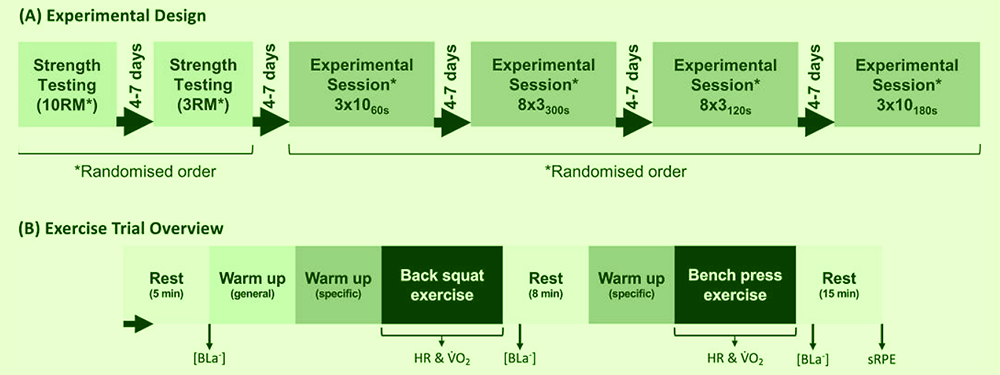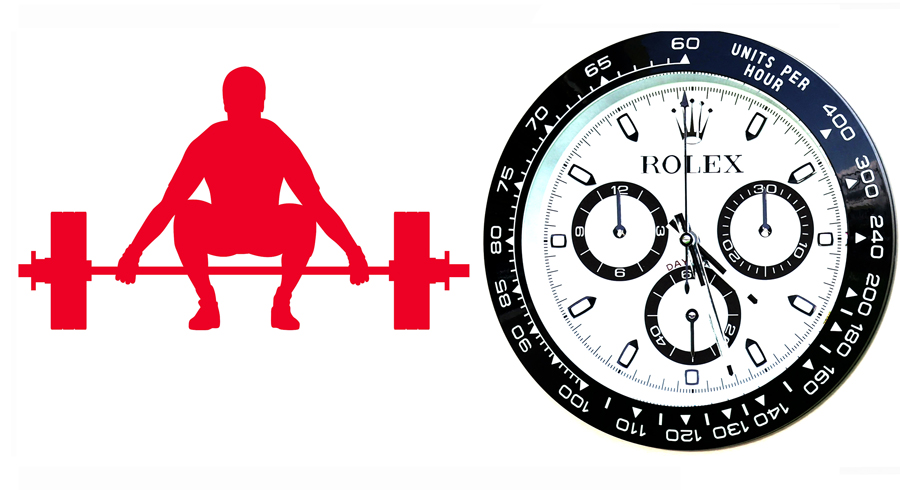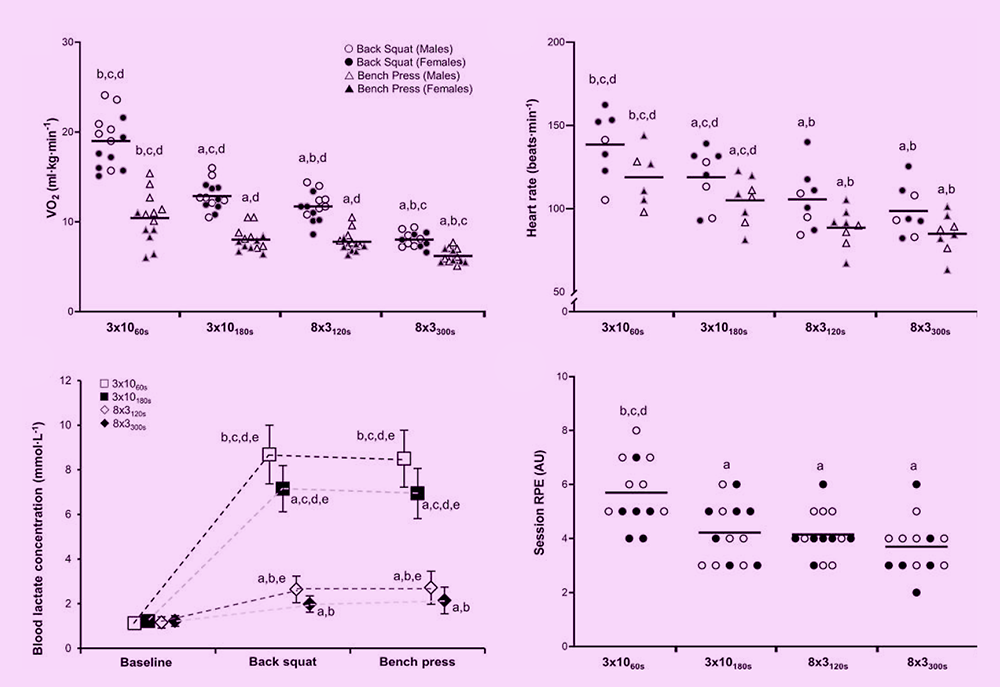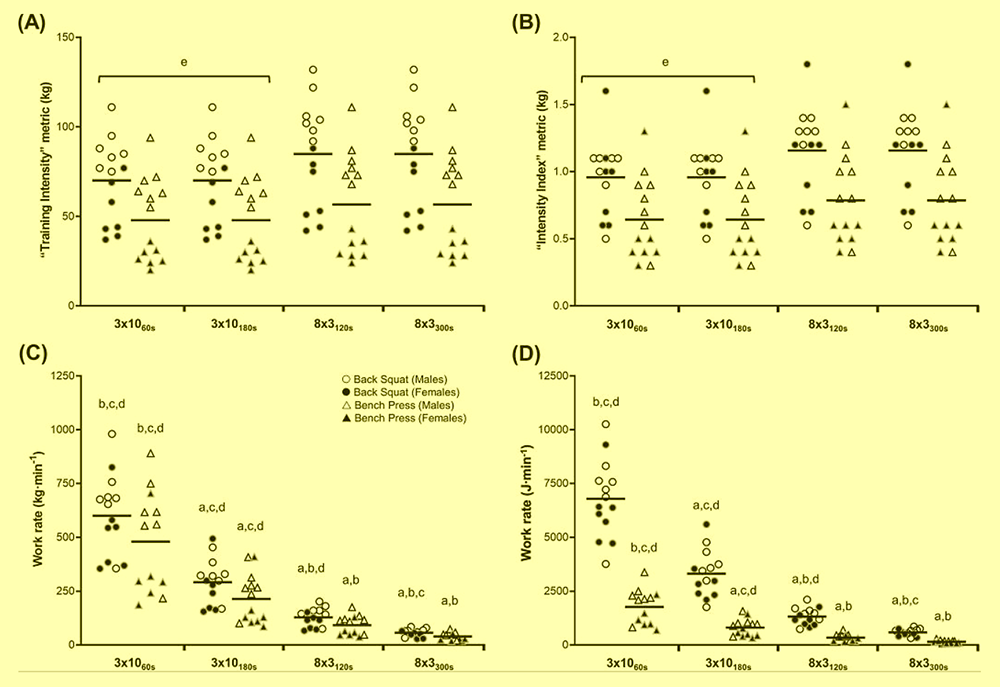You are viewing 1 of your 1 free articles. For unlimited access take a risk-free trial
Strength training intensity: time matters
SPB looks at new research on training intensity during strength workouts. Just what is ‘intensity’, and how can it be monitored and adjusted for optimum results?
Regular readers will be aware that the subject of maximizing strength training workouts by optimizing the workload – for example, the weight/resistance used, numbers of reps and sets, how close you should train to failure and the frequency of workouts – has been much discussed in previous SPB articles. The underlying principle however remains the same: to generate enough training load and intensity to create a training adaptation, but to do it in a way that maximizes the strength gains achieved while minimizing fatigue and time invested.
The role of overload
Different athletes have different goals when resistance training. Some seek to build general strength and resilience, while others want specific strength gains to help with a sport or activity, or to prevent/recover from injury. But whatever the goal, you can’t escape the basic laws of exercise physiology; specifically, if you want to improve muscle function, you need to generate an ‘overload’ stimulus in that muscle(1), and then allow the process of rest and recovery to take place. The term ‘overload’ in this context doesn’t mean subjecting to the muscle to harmful and damaging amounts of physical abuse, but it does mean challenging the muscle by asking it to do significantly more work than its current level of conditioning allows for, which then creates a training adaptation(2).
Overload and training intensity
Ask most athletes how to make their strength workouts harder and more intense in order to generate more a bit more overload and you’ll probably get an answer that involves performing more reps per set, more sets, more weight in each set, or some kind of combination of these factors. But while this kind of answer is commonplace and true to a degree, it doesn’t really get to the nub of what intensity is all about.
Intensity is not a measure of how much resistance is used, or even the number of sets/reps that are performed. Intensity is all about packing a lot of high-quality muscular work into a small volume of time. This doesn’t mean running around the gym like a headless chicken, throwing weights around at high speed! What it does mean is that for each muscle group, strength exercises should be performed with enough high quality repetitions and resistance performing in order to properly challenge the target muscle fibres – and that athletes perform sets and move onto different exercises with minimal rest.
This approach to generating intensity in a strength workout (ie condensing a given workload into a short time span with minimal rest in between sets was first pioneered by the eccentric (no pun intended!) but legendary Arthur Jones, the father of the Nautilus training technique – see this article(3). Jones had long understood the importance of generating intensity in muscle conditioning and his Nautilus machines were designed to generate intensity. This was executed by performing just one set of strictly executed reps for each major muscle group in the body, performed to ‘failure’, moving from one machine to another without resting or pausing, with a complete body workout taking just 12-15 minutes!
The science of strength training intensity
Let’s unpack the concept of strength training intensity a little further. The traditional view of ‘strength training intensity’ defines it as the load/resistance lifted across a particular exercise or training session divided by the number of reps in which it is achieved(4). Of course, athletes who are naturally heavy and powerfully built will lift more for the same effort, so an alternative way of defining intensity is to relate total load lifted ÷ reps to the bodyweight of the athlete – ie effort per kilo of bodyweight(5). This then becomes (total load lifted ÷ reps)/weight in kilos. So for example, a 65kg distance runner might have an ‘total load lifted ÷ reps’ score that is only two thirds that of a 90kg athlete, but the amount lifted per kilo of bodyweight will actually be very similar in both cases.
Time matters in intensity
The average load per rep per kilo of bodyweight sounds like a very useful way to measure strength workout intensities, and indeed it is - if you are only considering the intensity of the work itself – ie the external workload. However, what this intensity measure does not do is measure the internal loading on the body of the athlete – ie what the athlete experiences and feels in terms of perceived exertion. That’s because it takes no account of the inter-set rest periods during resistance exercise, which affects the ‘internal intensity’ of a session(6). Adding in rest periods ‘dilutes’ the intensity of the session, with longer rest periods creating more dilution.
As a rather extreme analogy, imagine a well-trained runner running his/her faster ever marathon, and the fatigue that would be experienced afterwards - not to mention the recovery time to resume normal training. Now compare that with running at that same marathon pace for just 3.75 miles per day for seven days (ie with over 23.5 hours rest in between each run). At the end of that week of accumulating the marathon mileage, he or she would almost certainly feel zero fatigue, but will have also generated virtually no marathon training effect!
A better way of measuring real intensity (external and internal) therefore is to take into account inter-set rest durations and therefore total exercise time – ie work done per kilo of bodyweight per unit of time. This is calculated by dividing the total work or loading by the training session duration(7) or summed duration of inter-set rest periods(8). When calculated directly from measured work, this measure equates to the mean power output across an entire exercise session(9).
Possible downsides
Performing strength training sessions at a higher work rate – ie resting less in between sets, thereby performing the same number of sets at the same weights and reps in a shorter period of time - elevates levels of blood lactate and growth hormone, and stimulates positive longer term muscular adaptations such as greater muscle cross-sectional area, and higher levels of strength, and endurance(10). There is a big possible downside however; if this increased workout intensity is not monitored appropriately, over an extended period of time, the greater metabolic demand can increase an athlete’s risk of staleness, burnout or overtraining syndrome(11).
Given the balance between the rewards that high-intensity training brings and the potential risks, what is needed is an understanding of exactly how manipulating the work rate (by reducing rest times and condensing a given volume of work into a shorter time period) affects measures of internal loading – ie perceived exertion and fatigue, heart rates, blood lactate etc. Surprisingly however, up until now there’s not been any research into this topic, nor has there been any comparison between the more traditional ways that measure intensity purely by external means (ie work done/reps but not taking total time and rest periods into account).
New research
To try and find answers to the above, a team of Aussie scientists has investigated the effects of increasing intensity by manipulating rest periods in between sets and compared the findings to the more traditional measures of intensity(12). Published in the science journal ‘Plos One’, this study investigated a variety of workout structures on 14 experienced resistance-trained participants.
Following a couple of familiarization trials, the seven male and seven female participants completed four different exercise protocols in a randomized order, each separated by 4–7 days. All the trials were matched for the relative effort necessary to lift different loads (ie sets of 10 performed at 85% of 10-rep max, sets of 3 with 85% of 3-rep max), but varied in the absolute load being lifted and/or the inter-set recovery time. These protocols were chosen as typical and widely used examples of exercise prescription using different loads(13). The protocols were as follows (see figure 1 also):
- A: 3x10 reps at 85% 10RM and 60 seconds inter-set rest.
- B: 3x10 reps at 85% 10RM and 180 secs rest (ie same total loading as above but reduced intensity due to longer rests).
- C: 8x3 reps at 85% 3RM and 120 seconds rest.
- D: 8x3 reps at 85% 3RM and 300 seconds rest (ie same total loading as C but reduced intensity due to longer rests).
Note that the external loading in A and B were the same, but the internal loading was higher in A due to reduced inter-set rest. The same was true respectively for C and D. Internal exercise intensity was calculated using via objective measures such as rate of oxygen consumption (VO2max), heart rates and blood lactate concentration, along with subjective set and session perceived exertion measures. External intensity was calculated using the traditional metrics of reps and weight lifted.
Figure 1: Overview of trial protocols

What did they find?
The main findings were as follows:
- The objective measures of internal intensity (ie VO2max, heart rate and blood lactate concentrations) were highest for the protocols with the greatest work rate (ie most workload completed per unit of time) and lowest in those with lesser work rates.
- The highest objective internal intensity was recorded for the 3x1060s session, followed by the 3x10180s, 8x3120s and 8x3300s protocols. These findings perfectly matched the differences in work rate between protocols, which was highest in the 3x1060s session and lowest for the 8x3300s session – see figure 2).
- The perceived effort and subjective fatigue (ie internal intensity) was highest in the session with the greatest work rate – ie the 3x1060s session.
- There was a near perfect correlation were between work rate per unit of time and internal exercise intensity, while in marked contrast, the traditional methods of calculating intensity only using load and reps was very poorly correlated to internal intensity (see figure 3).
Figures 2&3: Measures of internal intensity and perceived effort (top). Measures of external intensity and correlation to work rate (bottom)
Figure 2 top: From top left to bottom right: VO2 (oxygen use), heart rates, blood lactate and perceived effort. Across all metrics, you can see that higher work rate per unit of time resulted in higher measures of internal loading.
Figure 3 bottom: A = traditional loading calculation in kilos per rep. B = traditional loading calculation in kilos per rep per kilo of bodyweight. Note how these measures of external intensity suggest that intensity is roughly the same across all the four protocols when in fact the actual work rates (and intensity experienced by athletes) are drastically different, being highest in the 3x1060s session and lowest in the 8x3300s session.
Practical recommendations for athletes and coaches
Unlike the findings from many other studies, where caveats are often needed and only tentative conclusions can be reached, the results of this new research are quite clear cut. Put simply, using the traditional method of weight lifted, reps and bodyweight to determine the intensity of a strength work and its impact on athletes is NOT a good way to determine overall intensity or to prescribe workloads for future sessions. Instead, using the simple estimation of work rate determined by the formula: (total kilos lifted ÷ by exercise duration in minutes) is a much better way of determining the overall intensity of resistance session.
For and athletes and coaches therefore, it is recommended that the time taken to complete a strength session is factored in when determining how hard that session is proposed to be. For exactly the same exercises, sets, reps and weights, simply reducing the rest time in between each set increases the intensity of the session, while increasing rest times reduces session intensity – just as the legendary Arthur Jones postulated over half a century ago!
Using time – specifically inter-set rest periods – as a factor that can be manipulated to determine session intensity has distinct advantages too. If you want to increase the intensity of a session and increase its potential for generating strength gains, you don’t necessarily need to increase the loading (which can increase the risk of injury) or the number of sets performed (which eats up valuable training time). You can simply reduce the rest period in between sets, which in turn has the added bonus of reducing the time taken to complete your session! There are also implications for those who like to record and track their strength sessions; simply noting reps, sets and weights is not enough. You also need to note the inter-set rest periods and time taken because this is critical for determining the overall impact of a session. In addition, it’s worth mentioning that when manipulating your inter-set rest periods, this should also include the time between different exercises – not just between sets of the same exercise. Remember, the session intensity is a function of total time taken from the first rep of the first exercise to the last rep of the last exercise!
Finally, when manipulating session intensity by reducing time taken, caution is required. Just as you would only add extra weight or reps very gradually to increase intensity, you should only try to reduce rest periods gradually. For example, if you typically rest for three minutes in between sets, don’t suddenly attempt to cut that to one minute – the dramatic increase in intensity that would produce will completely floor you! Instead, reduce that three minutes to 2 minutes 30 seconds to begin with and see how you go from there. Remember, Arthur Jones was right all along!
References
1. Am J Physiol Med. 1979; 58: 115-130
2. J Strength Cond Res. 2017; 31: 1362-1370
3. en.wikipedia.org/wiki/Arthur_Jones_(inventor
4. Strength Cond J. 1999;21(2):56–62
5. Prof Strength Cond. 2010;19:31–40
6. Sports Med. 2005;35(10):841–51
7. J Strength Cond Res. 2015;29(6):1564–9
8. Sci Report. 2017;7(1):5606
9. J Strength Cond Res. 2016;30(1):292–300
10. Med Sci Sports Exerc. 2005;37(6):955–63
11. Med Sci Sports Exerc. 2000;32(2):317–31
12. PLoS One. 2023 Oct 5;18(10):e0291857. doi: 10.1371/journal.pone.0291857. eCollection 2023
13. Essentials of Strength Training and Conditioning, 4th Edition. Champaign, Il: Human Kinetics; 2015. p. 439–70
Newsletter Sign Up
Testimonials
Dr. Alexandra Fandetti-Robin, Back & Body Chiropractic
Elspeth Cowell MSCh DpodM SRCh HCPC reg
William Hunter, Nuffield Health
Newsletter Sign Up
Coaches Testimonials
Dr. Alexandra Fandetti-Robin, Back & Body Chiropractic
Elspeth Cowell MSCh DpodM SRCh HCPC reg
William Hunter, Nuffield Health
Keep up with latest sports science research and apply it to maximize performance
Today you have the chance to join a group of athletes, and sports coaches/trainers who all have something special in common...
They use the latest research to improve performance for themselves and their clients - both athletes and sports teams - with help from global specialists in the fields of sports science, sports medicine and sports psychology.
They do this by reading Sports Performance Bulletin, an easy-to-digest but serious-minded journal dedicated to high performance sports. SPB offers a wealth of information and insight into the latest research, in an easily-accessible and understood format, along with a wealth of practical recommendations.
*includes 3 coaching manuals
Get Inspired
All the latest techniques and approaches
Sports Performance Bulletin helps dedicated endurance athletes improve their performance. Sense-checking the latest sports science research, and sourcing evidence and case studies to support findings, Sports Performance Bulletin turns proven insights into easily digestible practical advice. Supporting athletes, coaches and professionals who wish to ensure their guidance and programmes are kept right up to date and based on credible science.













